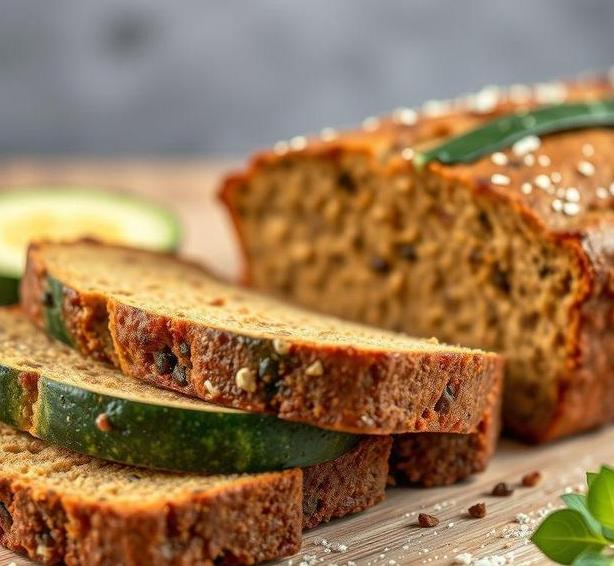Zucchini bread is one of those wonderfully comforting treats that combines the mild, sweet flavor of zucchini with the warmth and richness of spices, making it an incredibly popular baked good. Whether it’s a snack with coffee, a breakfast pastry, or a dessert, zucchini bread has a reputation for being both indulgent and deceptively healthy. It’s made from the moist, shredded vegetable, which keeps the bread incredibly soft and tender.
But like all baked goods, zucchini bread is not immune to spoilage, and it’s important to know how long you can enjoy it and when it’s time to toss it. Spoilage doesn’t always mean a visible change, so understanding the signs and proper storage methods is key to maximizing the freshness and shelf life of your zucchini bread.
In this guide, we’ll walk through everything you need to know about how zucchini bread can go bad, how long it lasts, how to tell if it’s spoiled, and the best ways to store it for optimum freshness.
Can Zucchini Bread Go Bad?
Yes, zucchini bread can absolutely go bad, just like any other bread or baked good. Though zucchini itself is a moisture-rich vegetable, which helps keep the bread moist for a while, this same moisture can also contribute to the bread’s eventual deterioration.
What makes zucchini bread particularly vulnerable to spoiling is that it is often made with fresh ingredients, including eggs, dairy, and moist zucchini. When exposed to air, humidity, or fluctuating temperatures, these ingredients can accelerate the growth of mold or bacteria, causing the bread to spoil. Not to mention, the sugar and fat in the bread can promote rancidity in certain conditions, making it go bad faster than you might expect.
Zucchini bread doesn’t spoil overnight, but knowing the signs of spoilage and the shelf life is critical for ensuring you’re enjoying the bread at its best quality.
Shelf Life For Zucchini Bread

The shelf life of zucchini bread can vary depending on how it’s stored and whether it’s homemade or store-bought. Here’s a breakdown of how long you can expect zucchini bread to last under different circumstances:
-
Room Temperature (Freshly Baked, Uncut)
If you’ve baked a fresh loaf of zucchini bread and plan to consume it within a few days, storing it at room temperature is fine. Wrapped in plastic wrap or kept in an airtight container, your bread should stay good for 3 to 4 days.
-
Room Temperature (Cut)
Once the loaf is cut, the exposed edges will begin to dry out. It’ll typically last for 2 to 3 days at room temperature, but it’s still safe to eat as long as there are no signs of spoilage (more on that below).
-
Refrigerator (Uncut Or Cut)
Storing zucchini bread in the fridge can extend its shelf life to around 1 week, even if it’s cut. However, refrigeration can sometimes cause the bread to dry out more quickly, so it’s best to ensure it’s wrapped tightly to avoid moisture loss.
-
Freezer (Uncut Or Cut)
Zucchini bread freezes exceptionally well. If you want to store it for a longer period of time, you can freeze it for up to 2 to 3 months. Just make sure it’s tightly wrapped in plastic wrap and placed in a freezer-safe bag or container to protect it from freezer burn.
-
Store-Bought Zucchini Bread
If you bought your zucchini bread from a store, check the expiration date on the packaging. Generally, store-bought zucchini bread contains preservatives, so it can last for up to a week at room temperature and up to 2 weeks in the fridge.
Common Signs Of Spoilage
It’s essential to recognize when your zucchini bread has gone bad, and some signs are more subtle than others. Here are a few things to look out for:
-
Mold
The most obvious sign of spoilage is mold. If you see any green, white, or black fuzzy patches on your zucchini bread, it’s time to toss it. Even if the mold is only on one part, it’s safest to discard the entire loaf because mold can spread throughout the bread.
-
Off Smell
Zucchini bread should smell sweet and comforting, with hints of cinnamon, vanilla, or whatever spices you’ve used. If it starts to smell sour or like rotten fruit, that’s a strong indicator that it’s spoiled. The presence of an off smell could also suggest bacterial contamination or fermentation, so don’t risk it.
-
Dryness Or Hardness
While zucchini bread tends to be a bit more moist than other types of bread, it can still dry out over time. If the bread becomes overly dry or hard, especially on the edges, it might be past its prime. Though it’s still safe to eat, the texture won’t be as pleasant, and it may not taste as fresh.
-
Change In Texture Or Discoloration
Another sign of spoilage is a significant change in texture. If the bread becomes soggy, sticky, or overly crumbly, this could indicate that it has gone bad. Additionally, if the bread turns an unappetizing color (e.g., darker or too brown), this could be due to oxidation or the bread starting to rot.
-
Unpleasant Taste
If you notice an odd, sour, or bitter flavor when you take a bite, that’s a sure sign that the zucchini bread has gone bad. At this point, it’s best not to continue eating it.
How To Store Zucchini Bread?

Proper storage is key to maximizing the shelf life of zucchini bread and preserving its freshness. Here are a few ways you can store your loaf:
-
Room Temperature
-
Airtight Container
If you plan to eat the bread within a few days, store it in an airtight container or wrap it tightly in plastic wrap. This helps maintain its moisture while preventing it from becoming too dry. Make sure the container is sealed to protect it from air and humidity.
-
Bread Box
A bread box is a great way to store zucchini bread if you don’t have an airtight container. It allows the bread to breathe while still keeping it away from contaminants.
-
Refrigeration
-
Plastic Wrap & Aluminum Foil
If you want to extend the bread’s life in the fridge, wrap it in plastic wrap, then foil to seal out moisture. Refrigeration will help keep bacteria at bay but can dry out the bread, so keep it tightly sealed.
-
Airtight Storage Container
Using a container that locks in the air and prevents moisture from escaping can help prolong the life of the bread. Be sure to store it in the fridge, and it should last up to a week.
-
Freezing
-
Plastic Wrap & Freezer Bag
If you want to save your zucchini bread for later, wrap it tightly in plastic wrap to prevent freezer burn. Then, place it in a freezer-safe bag. Freezing it will keep the bread fresh for up to three months, and when you’re ready to eat it, just thaw at room temperature.
-
Slice Before Freezing
If you don’t want to defrost the entire loaf, slice it before freezing. This way, you can remove individual slices and enjoy them without needing to defrost the whole loaf.
Expert Tips
-
Don’t Overmix
One common mistake when making zucchini bread is overmixing the batter. This can cause the bread to be dense or overly moist, which can shorten its shelf life. Mix until the ingredients are just combined for the best texture and longevity.
-
Check For Moisture
Zucchini contains a lot of water, so it’s a good idea to squeeze out excess moisture from the shredded zucchini before adding it to your batter. Too much moisture can lead to a soggy, short-lived loaf.
-
Use Wax Paper Or Parchment Lining
For easy removal from the baking pan, line the pan with wax paper or parchment. It will also prevent the crust from getting too wet and soggy during storage.
-
Consider Freezing Slices For Convenience
If you know you won’t finish the entire loaf, slice it first before freezing. This way, you can pull out individual pieces whenever you want a snack without having to defrost the whole loaf.
FAQs
Can Zucchini Bread Go Bad At Room Temperature?
Yes, zucchini bread can go bad at room temperature. Typically, it can last about 2 to 3 days when stored in an airtight container or wrapped tightly in plastic wrap. However, it will start to lose its freshness after a day or two, and moisture can cause mold growth if not properly stored.
How Long Does Zucchini Bread Last In The Fridge?
Zucchini bread can last up to 1 week in the refrigerator when stored in an airtight container. The cold temperature helps slow down spoilage and keeps the bread moist. However, it is best enjoyed within the first few days for optimal flavor and texture.
How Can You Tell If Zucchini Bread Has Gone Bad?
You can tell if zucchini bread has gone bad by checking for visible mold, an off smell, or a change in texture (like excessive dryness or sogginess). If the bread appears unusually wet or slimy, it’s likely spoiled. Additionally, if the bread has been sitting at room temperature for more than a few days, it may be unsafe to eat.
Can Zucchini Bread Be Frozen To Extend Its Shelf Life?
Yes, zucchini bread can be frozen to extend its shelf life. When properly wrapped in plastic wrap and aluminum foil or stored in an airtight container, it can last for up to 3 months in the freezer. Be sure to let the bread cool completely before freezing it to prevent excess moisture.
Does Zucchini Bread Go Bad If You Add Nuts Or Chocolate Chips?
Adding nuts or chocolate chips does not significantly affect the shelf life of zucchini bread. However, these ingredients may contribute to a quicker loss of texture or flavor after several days. Nuts can sometimes become rancid more quickly when exposed to air, so it’s best to consume the bread sooner if it contains them.
Can You Eat Zucchini Bread After The Expiration Date?
If zucchini bread has passed its expiration date, it’s best to assess its condition first. If it looks moldy, smells off, or has changed significantly in texture, it’s safer to discard it. If stored properly, some bread may last a bit beyond its date, but caution should be taken.
How Should Zucchini Bread Be Stored To Prevent Spoilage?
To prevent spoilage, zucchini bread should be stored in an airtight container or wrapped tightly in plastic wrap to keep moisture in and air out. If keeping it at room temperature, consume it within 2-3 days. For longer storage, refrigerate or freeze the bread.
Can Zucchini Bread Be Left Out Overnight?
Yes, zucchini bread can be left out overnight, provided it is stored properly. Keep it in an airtight container or wrap it in plastic wrap to protect it from moisture and air. However, it’s best consumed within the next 1-2 days to maintain its quality.
Is It Safe To Eat Zucchini Bread If It’s Slightly Dry Or Stale?
If zucchini bread is slightly dry or stale, it is still safe to eat, but it may not have the best flavor or texture. You can revive it by reheating the bread in the microwave or oven. If the bread shows signs of mold or an off smell, however, it should be discarded.
Can Zucchini Bread Go Bad Faster In A Warm Climate?
Yes, zucchini bread can go bad faster in a warm climate due to higher temperatures promoting bacterial growth and moisture accumulation. In such conditions, it’s best to store the bread in the refrigerator or freeze it if you won’t be consuming it quickly.